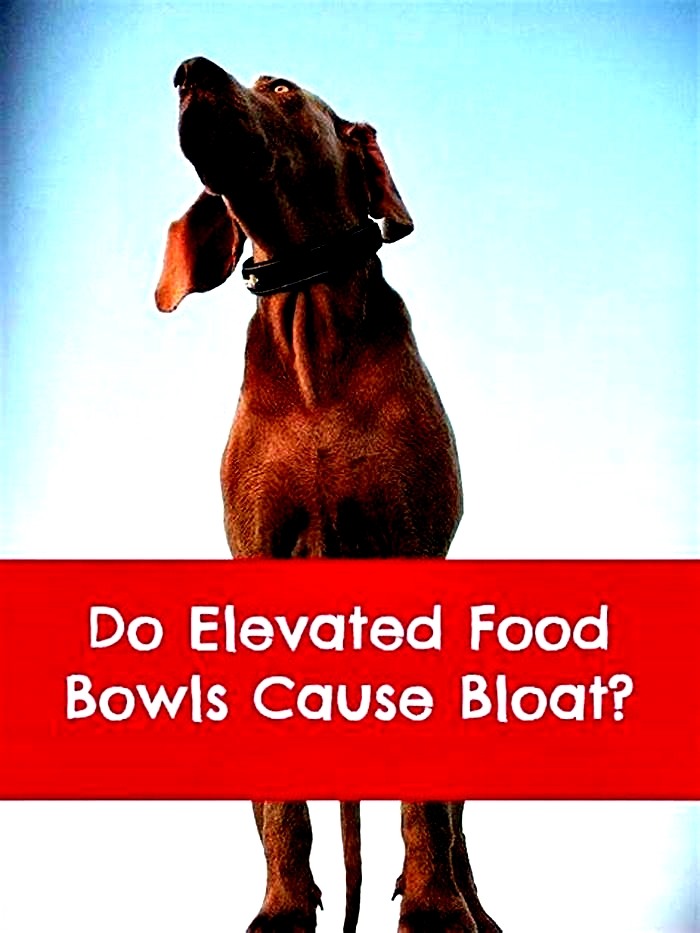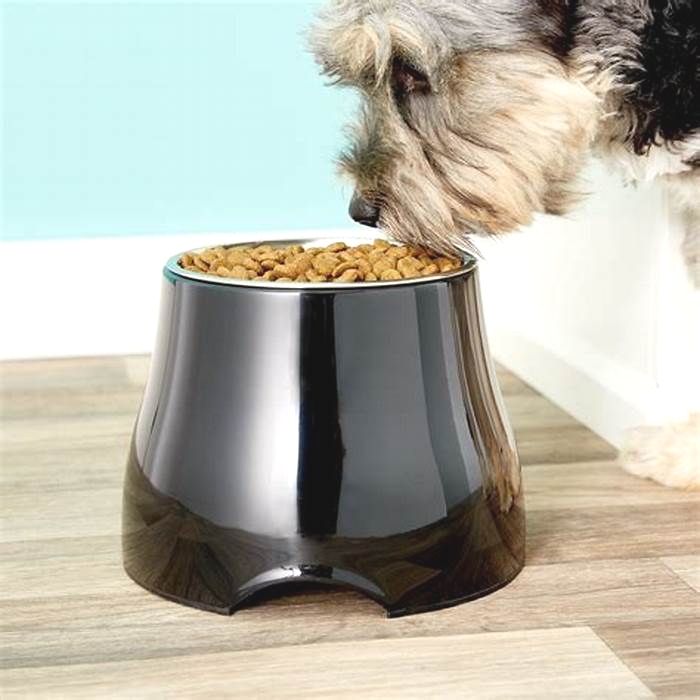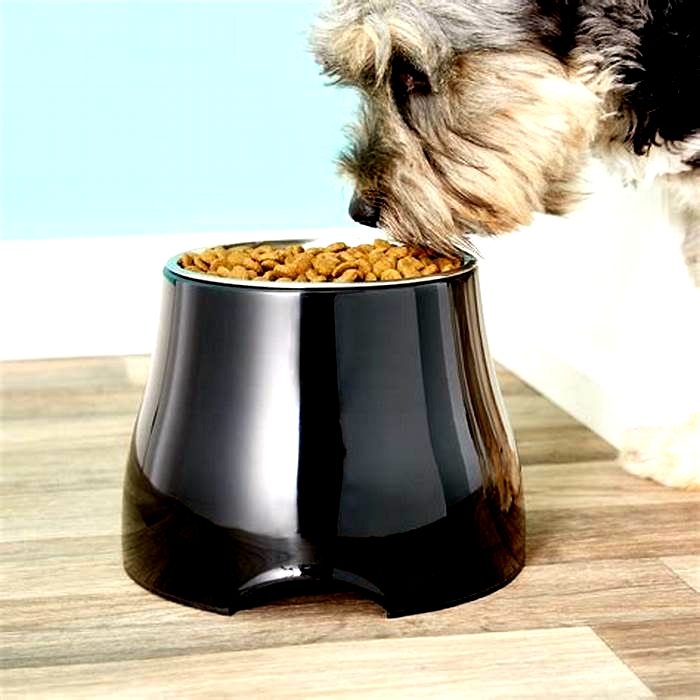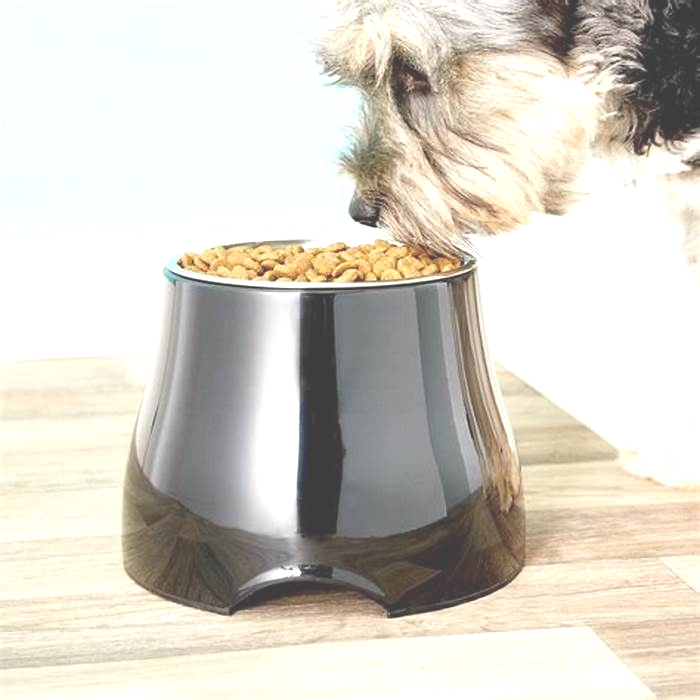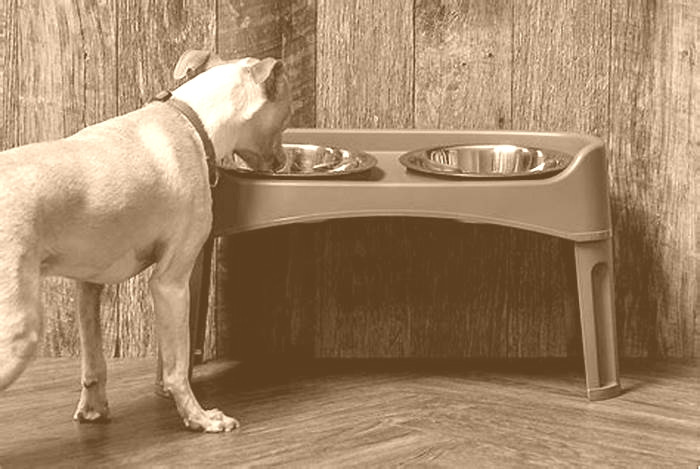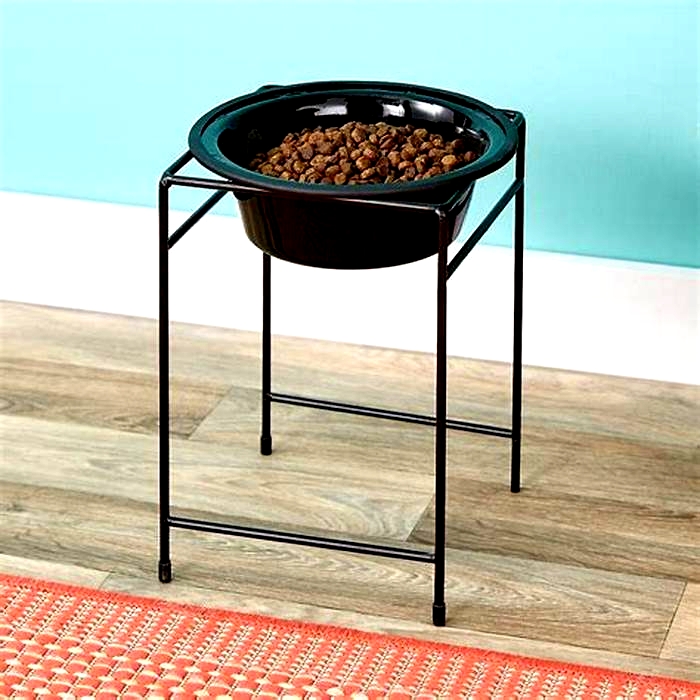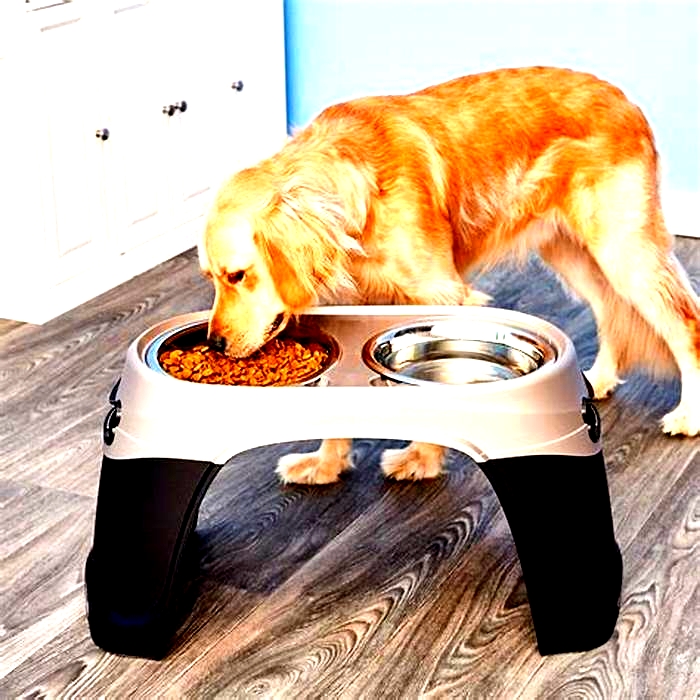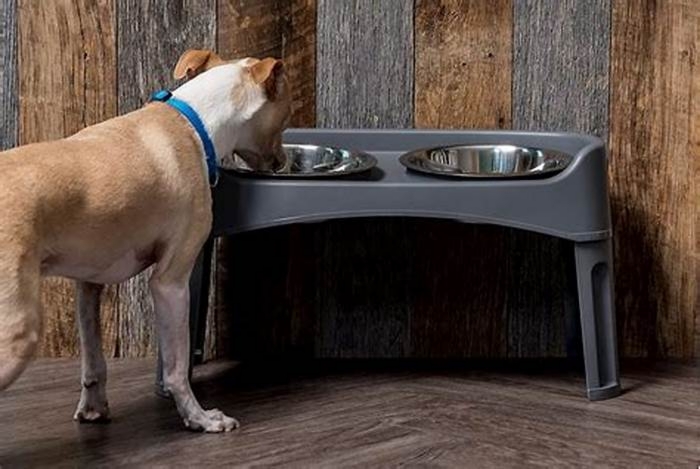Do elevated bowls cause bloat
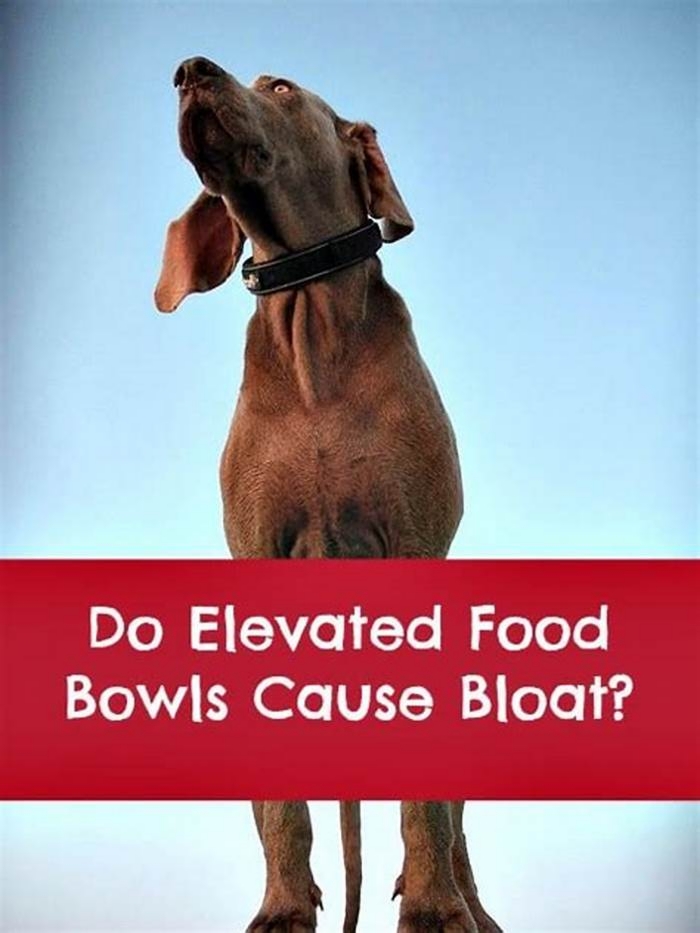
How an Elevated Dog Feeder Could Lead to Bloat
Elevated feedershave been identified as a non-dietary risk factor for
dog bloat. Elevated feeders do have some benefits, however, they may not be the best choice from a health perspective since some breeds are already susceptible to bloat.
What is bloat
Bloat in dogs, gastric dilatation and volvulus (GDV), occurs most commonly in large breed dogs and is life-threatening. Bloating of the stomach is often related to swallowed air, although food and fluid can also be present. The stomach swells and twisting occurs between the esophagus and upper intestine. Bloat can occur with or without twisting. The bloated stomach obstructs veins in the abdomen, leading to low blood pressure, shock, and damage to internal organs. The combined effect can quickly kill a dog.
Deep-chested dogs, such as German Shepherds, Great Danes, and Dobermans are particularly at risk. Smaller dogs, puppies, and less active dogs, while still susceptible to dog bloat, will not have as great a risk as larger more active dogs. Male dogs are much more likely to suffer from bloat than female dogs.
Causes of bloat
Some causes are believed to be rapid eating, elevated food bowls, dry foods that contain citric acid as a preservative, dry foods that contain fat among the first four ingredients, insufficient pancreatic enzymes, dilution of gastric juices necessary for complete digestion by drinking too much water before or after eating, eating gas-producing foods, drinking too much water too quickly, heredity-especially having a first degree relative who has bloated, build & physical characteristics and disposition. In addition to the risk factors listed, many veterinarians believe that stress also causes bloat.
Benefits of elevated feeders
Elevated dog feeders offer your dog some real health benefits. Dogs tend to lift their heads after taking a drink to facilitate swallowing. With an elevated feeder, they do not have to raise their heads as far. Your dog is able to maintain better posture and a more comfortable stance while eating and drinking. An improved posture causes less stress on your dog's back and joints. This is important for senior, arthritic or dogs with other conditions that make swallowing difficult.
Effects of elevated feeders
It's inadvisable to use elevated feeders if you have a dog already susceptible to bloat. An elevated feeder may increase your dogs risk for bloat especially if he/she has a relative who has bloated.
Research Findings
Scientists at many locations have been studying gastric dilatation and volvulus (GDV), commonly called bloat, for a long time. They have identified a number of likely factors, including behavioral traits. Breed susceptibility is pretty obvious for many deep chested dogs. The risk of bloat does appear to increase with age.
The Glickman et al study found that use of a raised feeder increases the risk of bloat by 110%. Dr. Glickman's data showed that "approximately 20% and 50% of cases of GDV among the large and giant breed dogs, respectively, were attributed to having a raised food bowl." (J Am Vet Med Assoc 2000;217:1492-1499). It should be noted that Dr. Glickman's study was confined only to large and giant breed dogs.
However, studies on risk factors for bloat associated with elevated feeders are unclear. Conflicting results from research studies is not that uncommon. Results may differ because different techniques are used or other medical conditions are present. Elevated feeders could also influence other factors such as the speed of eating. More research needs to be done on GDV in relation to using elevated feeders. It is uncertain whether anything we do such as changing the amount of exercise, using elevated feeders, or speed of eating will decrease or increase the rate of bloat.
Bloat (or GDV) in Dogs: What Is it and How Is it Treated?
If you believe your dog is suffering from symptoms of bloat, call your vet or emergency vet immediately.
I hate this disease. When I first started as a vet, we gave a dog with bloat a 50-50 chance if he could walk into the hospital. Many were too weak and had to be carried in. They often died. Now, 30 years later, bloat still kills about 30 percent of the dogs it affects, even after extremely intensive treatment.
I hope you never see this disease in your dog, but learning about what it is, why it happens, and how its treated may help your dog fall into the percentage of dogs that survive. Read on for common questions about bloat and new perspectives on prevention.
What Is Bloat in Dogs?
Bloat, also known as gastric dilatation-volvulus (GDV) complex, is a medical and surgical emergency.
As the stomach fills with air, pressure builds, stopping blood from the hind legs and abdomen from returning to the heart. Blood pools at the back end of the body, reducing the working blood volume and sending the dog into shock.
If this isnt enough, there is yet another scary thing that happens, and it is devastating to see. As the stomach flips, it drags the spleen and pancreas along with it, cutting off the blood flow. The oxygen-starved pancreas produces some very toxic hormones. One, in particular, targets the heart and stops it cold. In fact, a dog can go through successful treatment and seem to be out of danger, when suddenly the heart stops.
Even in the mildest case of bloat, which is extremely rare, dogs die without treatment.
What Are the Signs of Bloat in Dogs?
- An enlargement of the dogs abdomen
- Retching
- Salivation
- Restlessness
- An affected dog will feel pain and might whine if you press on his belly
Without treatment, in only an hour or two, your dog will likely go into shock. The heart rate will rise and the pulse will get weaker, leading to death.
Why Do Dogs Bloat?
This question has perplexed veterinarians since they first identified the disease. We know air accumulates in the stomach (dilatation), and the stomach twists (the volvulus part). We dont know if the air builds up and causes the twist, or if the stomach twists and then the air builds up.
How Is Bloat Treated?
Veterinarians start by treating the shock. Once the dog is stable, hes taken into surgery. We do two procedures. One is to deflate the stomach and turn it back to its correct position. If the stomach wall is damaged, that piece is removed. Second, because up to 90 percent of affected dogs will have this condition again, we tack the stomach to the abdominal wall (a procedure called a gastropexy) to prevent it from twisting.


How Can Bloat Be Prevented?
For years, veterinarians have been looking for ways to prevent bloat. If you search on the Internet, you will find a host of suggestions, but much of it is folklore. We have to look at what is scientifically proven and implement those strategies.
Risk of bloat is correlated to chest conformation. Dogs with a deep, narrow chest very tall, rather than wide suffer the most often from bloat. Great Danes, who have a high height-to-width ratio, are five-to-eight times more likely to bloat than dogs with a low height-to-width ratio.
In addition to Great Danes, large- or giant-breed dogs at greatest risk include St. Bernards, Weimaraners, Irish Setters and Gordon Setters, Standard Poodles, and Doberman Pinschers. Males are twice as likely to bloat as females. Neutering or spaying has no effect on risk.
If a dog has relatives (parents, siblings, or offspring) who have suffered from bloat, there is a higher chance he will develop bloat. These dogs should not be used for breeding.
Certain dietary ingredients have been blamed over the years, but the data is inconclusive. This is because most large-breed dogs are fed a cereal-based diet, so making a statement that those diets are to blame is difficult. However, we do know that foods containing soybean meal or having oils or fats in the first four ingredients increase the risk by fourfold.
Over the years, I have seen studies that show that food bowls on the floor cause more cases of bloat, but a few years later this was debunked, and elevated food bowls are now known to be just as much of a risk. With these conflicting results, a solid recommendation cant be made.
Dogs fed one meal a day are twice as likely to bloat as those fed two meals a day. Rate of eating is also a contributor. Fast eaters have five times the risk than dogs that are slow eaters. Using slow feeder bowls with fingers (or center posts) or putting large rocks in the bowl slows dogs down physically, but its also important to address the anxiety that comes with feeding around other dogs, because that can be a risk factor. Stressed dogs and those that are hyperactive are more likely to bloat. Separating dogs at feeding times may help reduce anxiety and stress surrounding food. Unhappy or fearful dogs are twice as likely to bloat as those that are happy.
A recent trend is to perform a preventive surgical gastropexy on an at-risk dog. Often performed when a dog is sterilized, some veterinarians now do this procedure laparoscopically to reduce the invasiveness. Unfortunately, the hardest part is determining which dogs are at a high enough risk to warrant this surgery. It could be said that all the above-mentioned breeds should have this surgery performed. We just dont know if it is cost-effective. Consult with your veterinarian about this option.
We cant prevent all cases of bloat, but by implementing some of the above techniques, you may be able to reduce your dogs risk. If your dog shows signs of bloat, take him to a veterinarian or an emergency pet clinic immediately.
5 Benefits of Elevated Food Bowls for Dogs: Myths or Facts?
Over the years, there have been plenty of contention topics among dog owners are grains good or bad?
Should dogs be spayed or neutered before a certain age?
Can they see color?
However, one topic that has repeatedly been questioned is the benefit or detriment of elevated food bowls for dogsand how these now popular raised dog food bowls affect our pets.
What are elevated dog food bowls?
 An elevated dog food bowl is any pet food bowl that does not sit directly on the floor. The actual height of elevation of the bowl may vary based on design. There are elevated dog food bowls (also called raised dog food bowls) that come in set elevations for different-sized dogs.
An elevated dog food bowl is any pet food bowl that does not sit directly on the floor. The actual height of elevation of the bowl may vary based on design. There are elevated dog food bowls (also called raised dog food bowls) that come in set elevations for different-sized dogs.
There are adjustable raised pet food bowls that allow owners to choose a specific bowl height.
With the popularity of raised food bowls, many pet owners have wondered if they should ditch their old regular dog food bowls and start their canines on elevated ones due to the potential benefits they provide.
However, there's more to know about elevated pet food bowls than some sources may lead you to believe.

How to pick a raised dog food bowl?
If there are different heights for elevated bowls, how does one find the correct and perfect height of an elevated food bowl for a pet?
If you decide to switch from regular dog food bowls to using elevated feeders for your dog, height is the main component to consider, and it's essential to select a raised bowl at the correct height.
Measuring is key.
How to measure:
The best way to measure your dog to get the right elevated dog bowl is to get your Fido to stand with his legs directly underneath him.
From here, get a tape measure and measure from the floor up to the point where your dogs front legs meet the chest.
Alternately, you can measure from the floor up to your dogs shoulder and subtract between 3 and 6 depending upon his overall height.
You want to subtract 6 for larger dogs, whereas for smaller dogs, you would subtract 3.
Just remember: if you aim to reduce stress on your dog's spine or neck, you should use a raised dog food bowl tall enough to do this.
However, I recommend first reading this article and doing enough of your own research on using raised bowls, and here's why.
Elevated food bowls for dogs have been advertised as having many benefits for dogs' health.
Unfortunately, not all of those advertised benefits hold.
Lets take a look at some of these widely spread truths and falsehoods from a scientific viewpoint.
READ MORE:Mealtime Battle Regular Dog Bowl vs. Raised Dog Bowl
5 Myths and Facts ofElevated Food Bowls for Dogs
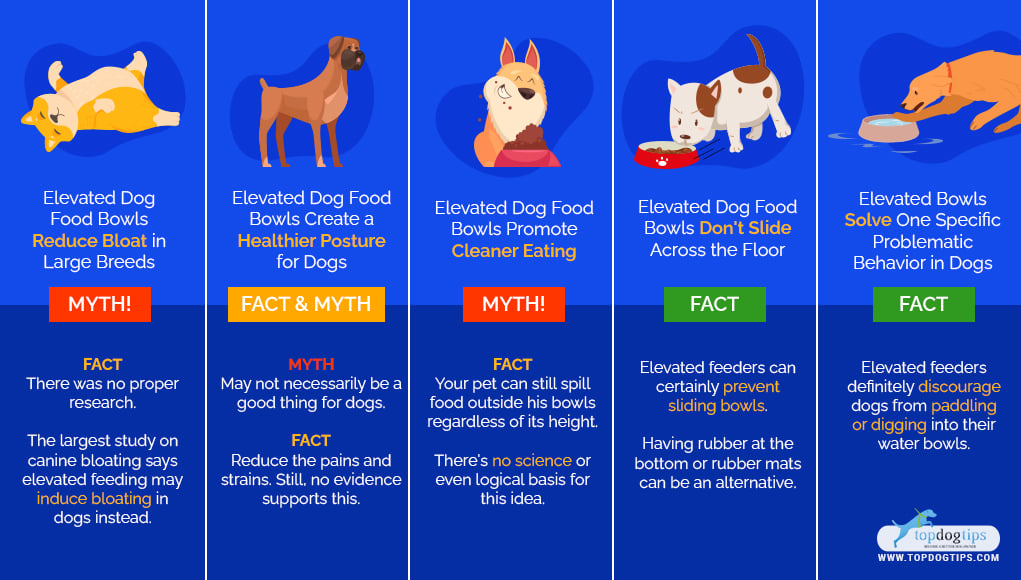
1 Elevated Dog Food Bowls Reduce Bloat in Large Breeds
This is FALSE.
When first promoted, raised dog food bowls were sold as something extremely beneficial for larger breed dogs at a higher risk of bloating.
This view was sold as science because it resulted from a statistical study (the Glickman Study).
However, this was no proper study, and the conclusion was extremely flawed.
All that this study did was look at the information of other available, non-science-based literature and anecdotal evidence that already existed and did no research into the matter at all.
In fact, the largest study on contributing factors to canine bloat in larger breed dogs to date says the exact opposite.
Elevated feeding may induce bloating in canines, especially in those with sensitive stomachs.
True, this study wasn't perfect; however, it's the best research paper we have to date.
From what research the scientific community currently has, the idea that elevated feeders can prevent bloat in large-breed dogs is questionable at best.
So, do elevated feeders for dogs reduce bloating in larger breeds? The correct answer here would be that we don't know for sure, but, likely, they DO NOT.
RELATED:5 Reasons Your Dog Has Canine Bloat and How to Prevent It
2 Elevated Dog Food Bowls Create a Healthier Posture for Dogs
This one is both TRUE and FALSE.
 Companies promoted elevated food bowls for dogs to prevent bloating in large dogs because they are supposed to create a healthier eating posture.
Companies promoted elevated food bowls for dogs to prevent bloating in large dogs because they are supposed to create a healthier eating posture.
The truth is that, most likely, dogs have evolved to eat in a head-down posture (sources: 1, 2, 3), so eating in a different posture may not necessarily be a good thing.
With that being said, in theory, this altered posture can be beneficial in other instances, such as older, arthritic, or injured dogs.
When a dog has a case of canine arthritis, joint pain, or immobility issues, eating with a head-down posture can cause excess strain and pain.
By raising your dog's food bowl, your pet no longer has to experience those pains and strains because they do not have to lean down as far to eat.
This has not been researched, though, and is mostly guesswork.
So, is elevated feeding good or bad for older or injured large-breed dogs? There is still controversy here, as I've indicated in my theory.
Since the evidence is scarce to support each side's benefits and detriments, it is a matter of the owner's preference.
RELATED:5 Best Collapsible Dog Bowls for Easy Travel
3 Elevated Dog Food Bowls Promote Cleaner Eating
This is FALSE.
Somewhere along the line (probably with new companies trying to sell the revolutionary raised dog food bowls and making stuff up) came the myth that elevated dog feeders promoted cleaner eating spaces for canines.
We arent sure where this idea came from, but this one is absolutely false and has no scientific or even logical basis.
Because of how dogs evolved to drink water and consume food, regardless of the height of your dog's food bowl, your pet can still spill kibble, drop kibble, or even move kibble outside of his bowl.
When dogs consume food, they have their mouths in the same proximity to the source regardless of height.
There is no science on how elevated dog food bowls promote cleaner eating, nor do we need it; watch your pooch eat.
4 Elevated Dog Food Bowls Don'tSlide Across the Floor
This is TRUE.
One concern that some dog owners have is the fact that their dog moves his bowl across the floor as he eats.
Elevated feeders can certainly prevent this from happening, and there's no doubt about that.
However, it is worth noting that a raised dog food bowl is not the only solution to the problem.
Just off the top of my head, two other things that can solve this issue are bowls with rubber on the bottom that prevents sliding or rubbery dog food mats where you can place your Fido's bowl to prevent sliding (which also helps to keep the area cleaner).
Therefore, because we have reasons to believe that elevated food bowls for dogs pose a potential hazard for some breeds to develop bloating, it may be better to choose alternative solutions to the sliding bowl problem rather than opt for an elevated feeder.
READ THIS:Dog Food Bowls That Slow Down Eating When Do You Need One?
5 Elevated Bowls SolveOne SpecificProblematic Behavior in Dogs
 This is TRUE.
This is TRUE.
One particular behavioral issue in dogs that isn't common but can be seen often enough for owners to start looking for solutions attempting to swim or dig into the water bowls, even if the bowl is small.
Some dogs, particularly those with a high predilection for water, spend a great deal of time trying to paddle in their water bowls as if it's the pool.
There's no explanation for this other than they like to be in the water.
The issue is most common with puppies.
Elevated feeders definitely discourage dogs from turning their water source into a pool.
VIDEO GUIDE:How to Choose the Right Dog Bowl (step by step)
The Final Verdict
Frustratingly, when I try to summarize my conclusions on the benefits of elevated food bowls for dogs, I must admit that there are both benefits and detriments to their use. Overall, I would say that the potential cons of using elevated dog food bowls outweigh the possible pros (unless you have a particular reason to use them).
So if you are considering using a raised dog food bowl for your Fido, my advice is that you weigh these pros and cons against your specific case and your specific dog before making your final decision.
Remember to consider the added cost of raised dog food bowls, especially if you're currently on a budget dog food diet.
Say you have a Great Dane and want to use an elevated feeder to reduce the strain on his neck and spine while eating.
Science indicates that an elevated feeder in larger dogs prone to bloating more easily is contradictory.
So, while your Great Dane may not experience strain in his neck from eating at an elevated feeder, the risk of bloating trumps this benefit.
Say you have a 14-year-old Basenji (a breed not particularly prone to bloat) with a severe case of canine arthritis in the neck, spine, and legs.
You want to use an elevated feeder to assist with posture-related pain and strain.
Common sense indicates that using an elevated feeder in this instance would be beneficial.
Potentially alleviating pain and strain and would not pose concerns of increased risk of canine bloat.
Whatever your decision, definitely speak with your veterinarian before making a switch to a new dog feeder.
Explain the concerns that you have and ask for advice on the best methods to fix them.
Maybe the answer is elevated food bowls for dogs, and maybe it's not.
Common Questions About Elevated Food Bowls for Dogs
If you still have any lingering questions about elevated food bowls for dogs, the following information should help.
Should a Dogs Food Bowl Be Elevated?
You should consider elevating your dogs food bowl if he is elderly or has issues with his joints or bones. Stick to other options if your dog is a larger breed.
Why Are Elevated Dog Bowls Bad?
Elevated dog bowls are only bad for certain dogs. Specific breeds are at a higher risk of bloat if they eat from an elevated bowl.
Do Elevated Dog Bowls Help?
Yes, elevated dog bowls can help your dog, especially if he has bad joints or bones. It can reduce the strain on his joints, including his hips and neck.
Do Raised Dog Food Bowls Cause Bloat?
Depending on the breed, elevated food bowls for dogs can cause bloat. Luckily, there are some things you can do to reduce the risk.
Let your pup take advantage of an elevated bowl.
Are our Raised Dog Bowls Dangerous?
As long as you know the risk of bloat and take proper precautions, raised dog bowls are not dangerous. To be safe, consult your dogs vet before switching him to an elevated bowl.
READ NEXT:Top 25 Best Puppy Food Brands (2018)



